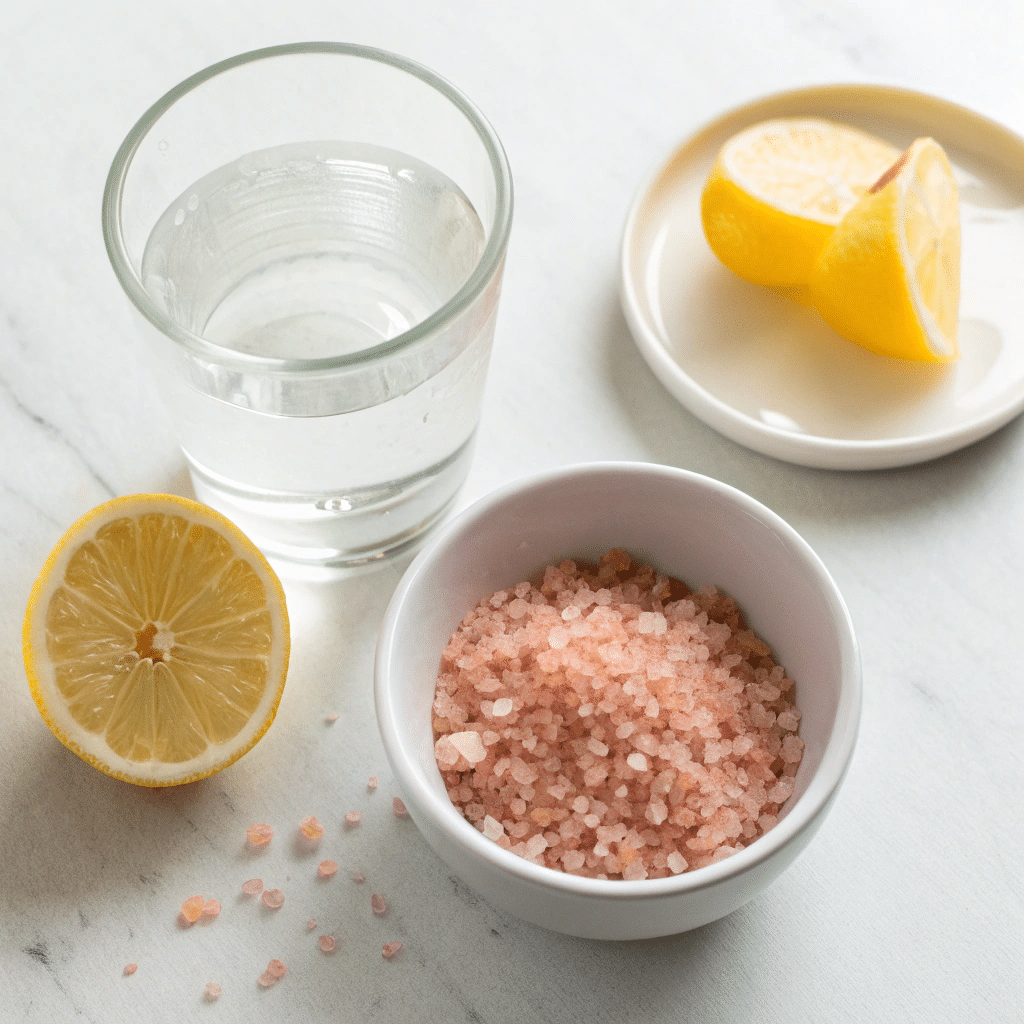The Japanese salt tonic isn’t just a trend; it’s rooted in centuries-old tradition. This mineral-rich blend has gained popularity as a natural way to rebalance the body and refresh the system. Today, I’m sharing how it became a staple in my morning ritual and how you can make it at home.
Japanese Salt Tonic Origins & Ritual
Japanese Salt Tonic: My Morning Reset Ritual That Actually Works
Japanese salt tonic is more than just a warm drink. It’s a tradition that helped me fix something I didn’t even know needed fixing my mornings. I used to wake up sluggish, reaching for coffee before water. But after reading about this simple blend of salt and water in a wellness journal from Japan, I gave it a try. Just warm water, mineral salt, and a few slow sips. No caffeine crash, no bloating, and surprisingly I started feeling fuller for longer.
In traditional Japanese culture, salt represents more than taste. It’s purity. Temples scatter it at their entrances. Sumo wrestlers toss it into the ring. And some families still use salt water every morning in a gentle cleansing ritual called misogi. It’s not about trends it’s about being present.
When you drink a Japanese salt tonic, you’re hydrating with intention. You’re giving your body what it actually needs first thing in the morning minerals, not sugar or caffeine.
I always use a clean, mineral-rich option like I shared in this Japanese pink salt recipe, because quality salt changes the whole experience.
Why the Salt Water Ritual Still Matters Today
Your body loses minerals while you sleep through breathing, sweating, and metabolic repair. The Japanese salt tonic helps replace sodium, magnesium, and trace minerals that water alone can’t give you. It also gently activates your digestive tract without shocking it, making it ideal before breakfast or even intermittent fasting.
Think of it like a natural switch for your metabolism. No gimmicks. No energy drinks.
Tip: Start Small to Avoid Overdoing It
Here’s a simple tip I wish I knew from day one:
Japanese Salt Tonic: Natural Morning Ritual for Energy & Digestion
- Total Time: 2 minutes
- Yield: 1 glass 1x
- Diet: Gluten Free
Description
A simple, mineral-rich Japanese salt tonic to support digestion, hydration, and morning energy.
Ingredients
10–12 oz warm filtered water
¼ teaspoon Japanese pink or Himalayan salt
½ teaspoon lemon juice (optional)
Instructions
1. Warm the water to sipping temperature.
2. Add salt and stir until fully dissolved.
3. Add lemon if using.
4. Sip slowly on an empty stomach.
5. Wait 15–20 minutes before eating.
Notes
Use only mineral-rich salt for best results.
Avoid drinking close to bedtime.
Optional to add lemon based on preference.
- Prep Time: 2 minutes
- Cook Time: 0 minutes
- Category: Drinks
- Method: No-Cook
- Cuisine: Japanese
Nutrition
- Serving Size: 1 glass
- Calories: 0
- Sugar: 0g
- Sodium: 580mg
- Fat: 0g
- Saturated Fat: 0g
- Unsaturated Fat: 0g
- Trans Fat: 0g
- Carbohydrates: 0g
- Fiber: 0g
- Protein: 0g
- Cholesterol: 0mg
Real Benefits of Japanese Salt Tonic
How the Japanese Salt Tonic Supports the Body Naturally
The Japanese salt tonic isn’t flashy, but it’s quietly powerful. What you’re really doing each morning is signaling your body that it’s time to start the day with clarity, hydration, and gentle support. While most people down a cup of coffee before their eyes are even fully open, this simple salt water blend gives your body something much more essential: minerals and balance.
Drinking warm water with just a pinch of mineral-rich salt helps restore electrolytes lost overnight. It also lightly stimulates digestion and encourages the body to release what it doesn’t need making you feel less bloated and sluggish without using any powders or supplements.
Here’s how it helps:
- Boosts cellular hydration by improving water absorption
- Encourages natural elimination and regularity
- Gently supports metabolism and adrenal function
- Helps with morning dizziness, fatigue, and even muscle tension
The best part? It fits easily into your day. No mixing, no blending, no prep. Just stir, sip, and let it work.
Tip: Use Herbal Balance During the Day
This isn’t a quick-fix trick. It’s a habit. And like many Japanese wellness practices, it’s rooted in subtle consistency. One glass might not change your life, but ten days of showing up for yourself quietly? That’s when you’ll start to feel it.
How to Make Japanese Salt Tonic at Home
Ingredients You Need for the Japanese Salt Tonic
The beauty of the Japanese salt tonic is in its simplicity. You don’t need anything fancy just clean ingredients and a few quiet minutes in the morning. I usually prepare mine before the house gets busy, and that little ritual alone shifts my entire mood. It’s not just a drink it’s a moment to reset.
To make one serving, here’s what you’ll need:
- 10 to 12 oz warm filtered water
- ¼ teaspoon Japanese pink salt (or Himalayan salt)
- Optional: ½ teaspoon fresh lemon juice (if your stomach handles citrus well)
Stick with mineral-rich salt only. Avoid table salt it’s stripped of everything your body actually needs. Personally, I stick to Japanese or Himalayan salt because the mineral content is noticeably higher, and you can taste the difference.
Instructions to Prepare the Tonic
Making a Japanese salt tonic couldn’t be easier, but the experience changes when you give it your full attention. Here’s how I do it:
- Warm the water to a comfortable sipping temperature not too hot.
- Add ¼ teaspoon of mineral salt and stir well until it dissolves completely.
- If you’re using lemon, add it now and give it a final stir.
- Drink it slowly, within 20–30 minutes of waking, before breakfast or coffee.
- Wait at least 15 minutes before eating or drinking anything else.
Some mornings I sip it while journaling, and others I just enjoy the silence before the day starts. It’s not about perfection it’s about presence. That’s the heart of the Japanese salt tonic: gentle, daily care that builds up over time.
When to Drink the Japanese Salt Tonic and Who Shouldn’t
The Best Time to Drink It for Maximum Benefit
The Japanese salt tonic works best when your body is still quiet first thing in the morning, before anything else hits your system. That’s when your cells are the most ready to absorb nutrients, and when your digestion is the most sensitive to gentle stimulation.
I recommend drinking it within 30 minutes of waking, on an empty stomach. If you’re practicing intermittent fasting, it’s even better this tonic won’t break your fast and will support your body’s detox naturally. Some people like to have a second cup before dinner, especially if they’ve had a high-sodium or high-carb lunch. That’s totally fine too. But the first-morning ritual is where the real magic lives.
Pairing this practice with light meals or herbal teas throughout the day can make the benefits more noticeable. That’s why I often recommend sipping something like barley tea or my favorite salt-friendly detox blend when I need to reset without overwhelming my digestion.
Who Should Skip or Modify the Salt Tonic
Like with any natural remedy, the Japanese salt tonic isn’t for everyone. If you have kidney issues, are on a sodium-restricted diet, or experience chronic water retention, you’ll want to talk with your healthcare provider before trying this. Pregnant women should also ask their doctor though many midwives suggest salt water for hydration, everyone’s needs are different.
If you’re sensitive to sodium or unsure how your body will react, start slow. Use a pinch of salt in a full glass of water and gradually increase only if you feel good. Some people report mild detox symptoms like loose stools or increased urination during the first few days this is normal and usually temporary. Just listen to your body.
And here’s a little note I learned the hard way: don’t drink it too close to bedtime. Salt water before sleep can lead to late-night bathroom trips or feeling too alert. Keep it early in the day for the best results.
Salt Tonic & Weight Loss What’s Real and What’s Not
Does the Japanese Salt Tonic Help You Lose Weight?
You might’ve heard the claim that the Japanese salt tonic melts fat, burns calories, and boosts metabolism overnight. Let’s clear something up it’s not a magic potion. But that doesn’t mean it’s useless either.
This tonic works by supporting the systems already designed to keep your body balanced. It can help with bloat, cravings, and digestion all important if you’re trying to manage your weight naturally.
Here’s how it supports your goals:
- It reduces water retention by regulating hydration
- It promotes smoother digestion, which leads to less bloating
- It may reduce stress-related cravings (especially salty snacks)
- It keeps you regular, which makes a big difference if you feel “puffy”
And when you’re consistent, that slight daily reset adds up over time. But you still need nourishing food, good sleep, and basic movement.
I noticed the biggest difference when I paired the salt tonic with light meals and morning walks. Some mornings I even followed it up with a sprinkle of chia or ground flax to keep my digestion moving.
Tip: Try Adding Seeds to Support Gut Health Naturally
It’s not about doing everything perfectly. It’s about stacking small choices that make your body feel good. That’s how sustainable weight balance happens with consistency, not restriction.
Long-Term Benefits and How to Keep It Sustainable
Why It’s Not Just a Trend The Salt Tonic Can Become a Lifestyle
Once you’ve tried the Japanese salt tonic consistently for a week or two, you’ll likely notice the subtle changes. Less morning grogginess, better digestion, and maybe even fewer cravings mid-morning. But here’s the real beauty of it it’s sustainable.
There’s no complicated prep, no fancy ingredients, and no giant shift in your diet. Just a pinch of salt, some warm water, and a few minutes of quiet. What it teaches without you even realizing is consistency. And that’s often the thing most of us struggle with.
Over time, this tonic can become the base layer of a wellness routine that supports energy, digestion, and mineral balance even as seasons change or life gets hectic.
Some people like to cycle it weekly, others make it a permanent morning ritual. Either way, it’s one of those small habits that keeps giving the longer you stick with it.
Tip: Combine with Other Natural Supports for Better Results
It’s not about doing 20 things perfectly it’s about having 1 or 2 grounded habits that you return to no matter what life throws your way. The Japanese salt tonic has become exactly that for me, and maybe it’ll be that for you too.
FAQ About Japanese salt tonic
What is the famous Japanese salt?
The most commonly known Japanese salt is moshio, a seaweed-infused sea salt that has been used in Japan for centuries. It’s known for its mild flavor and high mineral content, making it ideal for culinary and wellness uses like the Japanese salt tonic.
What is a salt tonic?
A salt tonic is a simple mixture of warm water and unrefined salt, typically consumed first thing in the morning to support hydration, digestion, and mineral balance. The Japanese version often includes pink or sea salt and may be paired with lemon.
What is the Japanese salt water ritual?
The Japanese salt water ritual, often part of misogi, is a cleansing practice that uses salt water to purify the body internally. It reflects a cultural belief in salt’s ability to cleanse, protect, and rebalance energy physically and spiritually.
What is the pink salt trick for weight loss?
The pink salt trick involves drinking a small amount of warm water mixed with Himalayan or Japanese pink salt in the morning to reduce cravings, support digestion, and promote fullness. While not a fat-burning solution, it can aid in healthy routines.
Conclusion
If you’re looking for a grounding, low-effort ritual to start your day, the Japanese salt tonic might be the exact thing your mornings have been missing. It’s not a miracle cure, and it won’t replace movement or good food but it supports the systems that keep you balanced, hydrated, and functioning at your best. With just a pinch of salt and a glass of water, you’re not only feeding your body you’re honoring it.
📌 Want to save this? Pin it to your Pinterest board for your next reset week.
💬 Tried this? Share how it worked for you on my Facebook page and tag @HommadeRecipes!




